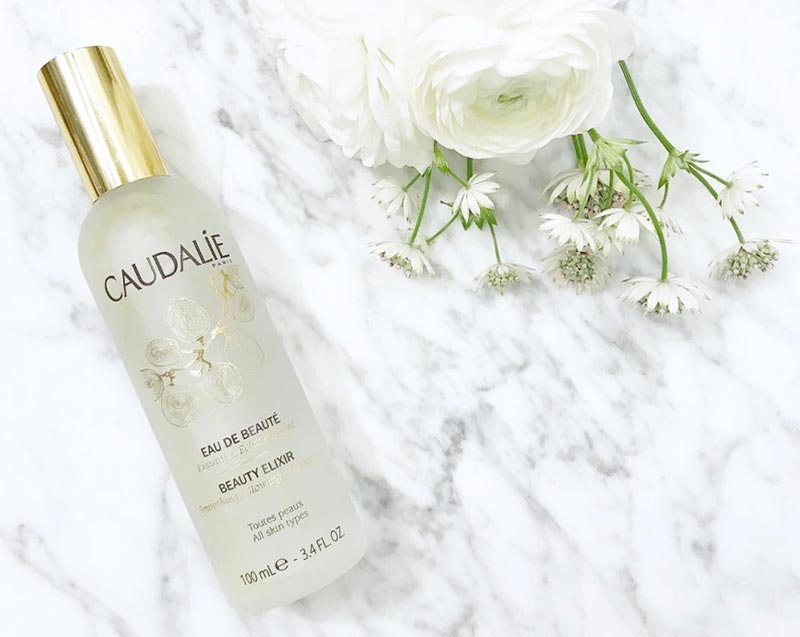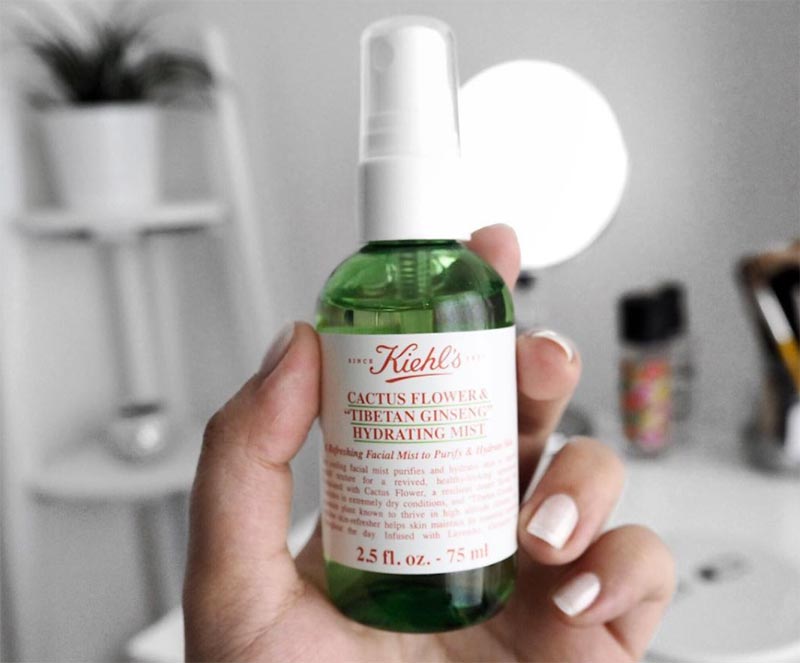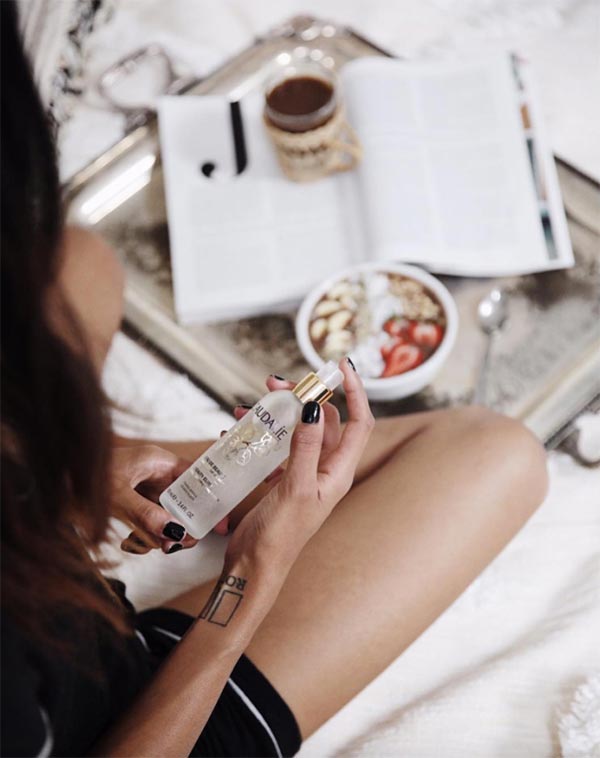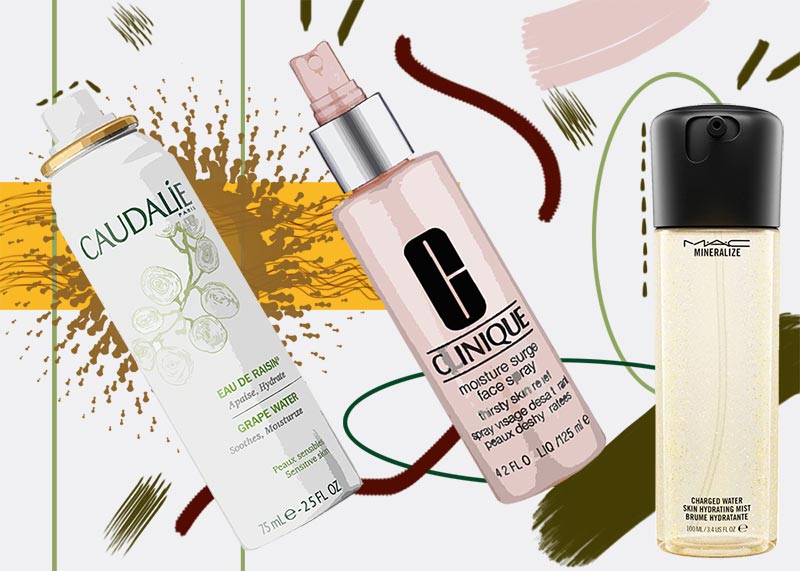Face mists are liquid skincare products that come in a bottle with a delicate spray/ mist dispenser, and can do a whole host of wonderful things to your skin. The primary purpose of a face mist is to moisten and hydrate the skin, making it ready to better absorb additional skincare products like face serums and moisturizers, but the really great face mists contain a lot of other active ingredients that can improve the skin in a variety of different ways.
In this article, we will explain exactly how face mists should be used for all kinds of benefits, how they differ from other skincare products, what kind of face mists there are, and how to choose the best one for you.
In this article:
- Should You Use a Face Mist?
- Pros & Cons of Face Mists
- Types of Face Mists
- Choosing a Face Mist for Your Skin Type and Concerns
- The Difference Between a Face Mist and a Toner
- How to Use a Face Mist
- DIY Face Mist Recipe
Should You Use a Face Mist?
So while face mists are not a mandatory skincare step, they are extremely pleasant to use and hold lots of extra benefits. Few things are as luxurious as spraying your face with the finest mist of a lightly scented, refreshing liquid.
You should definitely consider adding a face mist to your routine if you have been dealing with dehydration (especially a face mist with lots of humectants like glycerin or hyaluronic acid) – especially if you have oily skin, and want to avoid additional, heavy skincare steps. A good face mist can be the perfect solution, because it is light yet effective.
You may also want to add a face mist to your routine as a post makeup step, especially if your skin sometimes looks powdery once you’ve finished setting your foundation. For many of us, powder is mandatory if we want to have our foundation last for longer than an hour, but it takes away from the trendy dewy complexion we all crave. A face mist can help restore that shine to the skin.
Pros & Cons of Face Mists
The good:
- Face mists are awesome hydrators!
- They are super multifunctional.
- Using them is a wonderful and refreshing sensory experience.
- Face mists can soothe irritating skin.
- They can finish your foundation off beautifully.
- They are very portable.
- They don’t take any time to apply.
- Lovely on airplanes.
The bad:
- Absolutely nothing!
Types of Face Mists
There are a few different types of face mists, and you truly have to dive into the ingredients list to figure out what kind of face mist you have. I’ll talk you through some of the common face mists that you can buy, and how to figure out which one you might be looking at!
Hydrating Face Mists
These face mists contain water-binding ingredients called humectants, in a fairly high quantity (second or third on the ingredients list). The most common humectant used in face mists is called glycerin, but you might also see hyaluronic acid or propylene glycol.
These are the most hydrating face mists, and they work best under a moisturizer or as makeup setting sprays to give makeup a dewy finish.

Nourishing and Occlusive Face Mists
These face mists are actually super-light emulsions, because they include some botanical oils. These face mists can even replace a moisturizer, because they occlude the skin (meaning they create a protective barrier over the skin, and prevent moisture evaporation).
Nourishing face mists may or may not also contain humectant ingredients, and are best used as a final, or next to final step in the skincare routine. They don’t always work well after foundation.
Refreshing and Soothing Face Mists
In these face mists you won’t see botanical oils (although you might see fragrant essential oils) or humectants, but instead you’ll see a ton of botanical extracts or hydrosols (most frequently rose water or lavender hydrosol). These ingredients are loaded with antioxidant and anti-inflammatory compounds, and are phenomenal for soothing sensitive skin.
Refreshing face mists don’t hydrate as much as the previous two face mists do, and should always be followed up with moisturizer. They work quite well after makeup, but they don’t give as dewy a finish as a hydrating face mist.
Thermal Water
Thermal water works very similarly to extract- and hydrosol-based face mists. Thermal water is rich in naturally occurring minerals like selenium, copper, and magnesium that have both skin-protective and soothing properties.
They make the skin feel soft and supple, and much like the aforementioned extract-based face mists, they should always be followed up with a moisturizer.
Astringent Face Mists
These are basically toners in the form of a face mist. They come in the same misting spray bottle, but they contain pore-tightening and pH-balancing ingredients like witch hazel or cucumber extract. These are best for those with oily or acne-prone skin, and they can also work well to prep the skin for chemical exfoliation.
Choosing a Face Mist for Your Skin Type and Concerns
Usually, face mists are one-size-fits-all, so no matter which face mist you choose, it would probably help your skin in some way. However, those with specific skin types and concerns might prefer one type of face mist to the other.
Face Mists for Normal Skin
If you have normal skin that is not too dry or too oily, you will probably need more middle-of-the-road face mists. You may choose to avoid face mists that contain oils, and instead prefer ones that are simply hydrating or refreshing.
Face Mists for Dry and Mature Skin
If you have dry or mature skin, you want a face mist that is more heavy-duty. Look for richer face mists that have a lot of humectants, occlusives, and antioxidants, to moisturize, soothe, and strengthen your skin.
Face Mists for Oily, Combination, and Acne-Prone Skin
If you are already using an adequate moisturizer, you will probably want to use either refreshing and light face mists, or astringent face mists that will tighten your pores and control oil production. You can also choose a more hydrating face mist (maybe even one with light occlusives) to totally replace your moisturizer.
Face Mists for Sensitive Skin
Sensitive skin comes in all types of forms, so the key is to look for specific ingredients, and avoid others. Those with sensitive skin should look for skin-soothing ingredients, like green tea extract, aloe, or chamomile.
Additionally, some people don’t respond well to ingredients like essential oils, alcohols, or propylene glycol. If such ingredients tend to trigger redness in your skin, make sure to avoid them.
If your skin is extremely sensitive, you might choose to stick to something really simple like Avene thermal water. Whether you choose a more refreshing, light face mist, or a heavier one is totally up to you.

What’s the Difference Between a Face Mist and a Toner?
Distinguishing between face mists and toners is not easy, because sometimes they are one and the same. Naturally, a face mist has to come in a spray container, while a toner can come in any type of bottle with any dispenser.
The big difference is that the primary purpose of a face mist is to hydrate and refresh, while oftentimes the main purpose of a toner is to balance the skin’s pH or to tighten the pores. These two purposes are not necessarily mutually exclusive, with many companies releasing multi-functional products.
You can choose to use both a toner and a hydrating mist (especially if your toner doubles as an active treatment), or just the one.
How to Use a Face Mist
The beautiful thing about face mists is that they are fairly self-explanatory, as well as super multi-functional. There are three ways in which you could use a face mist.
The Classic Way
- Cleanse your skin well, making sure there is not residue of cleanser left behind.
- Next, spray your face with your face mist of choice. You should hold the bottle about 10 inches away from your face, with the nozzle facing way. 1 or 2 sprays should be enough to adequately cover your whole face.
- While your skin is still damp from the mist, follow it up with your usual serums and moisturizers.
This is a great skincare routine for both morning and evening.
For Light Cleansing
For many of us, a full cleansing is not necessary in the morning time. Instead, spray a cotton round with your face mist of choice, and wipe it all over your face in upward motions. This will remove that little bit of excess sebum that your skin produces overnight, while also loading your skin up with wonderful hydrating and nourishing ingredients.
Follow it up with the rest of your skincare routine, and a face sunscreen.
As a Finishing Skin Mist Throughout the Day
Most face mists also work really well as makeup finishing sprays, or as midday makeup refreshers. The hydrating ingredients in face mists will eliminate that overly matte finish of face powder without causing shine.
In the middle of the day, especially on hot days, a spray of a cooling face mist can really refresh both the skin and the mood, and can also make your makeup easier to blend, if you need to touch up your foundation or powder. This won’t work with all face mists, but it will certainly work with the simpler face mist formulas.

DIY Face Mist Recipe
This simple DIY face mist recipe can be made exactly as is, for a simple hydrating tonic, or it can be adapted with a variety of extracts, plant hydrosols, and essential oils, to achieve different skin benefits and consistencies.
Making your own skincare product is not an easy or simple procedure. Any water-based product (as all misting sprays are) can become breeding ground for bacteria very easily, so you should always be careful.
However, if you make sure to keep your DIY face mist in the skincare fridge, and to throw it away after a week, you will be fine. If you want to make a longer-lasting product, or something you can carry around with you on hot days, make sure to also use a preservative.
For this homemade face mist recipe you will need:
- 1 travel size spray container (2 oz. is ideal – any larger and your product will likely go bad before you even finish half of it)
- 1.8 oz. distilled water (or rosewater for extra refreshment)
- 2 oz. Glycerin
- 1-2 drops of an essential oil of your choice
Simply mix all of these ingredients in your spray bottle, and shake to mix. That’s it! You can now spray this lovely mist on either before moisturizer, or after you have finished your makeup.
Do you use face mists? How do you use them? Get in touch, and let us know!
Photos via Sephora, Instagram





